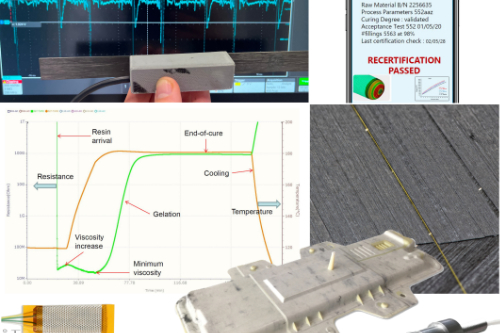Resin Transfer Molding (RTM)
Resin Transfer Molding (RTM) is a popular manufacturing technique in composite production, involving the infusion of resin into dry fiber reinforcements within a closed mold. This process offers precise control over resin distribution, resulting in high-quality, void-free composite parts. RTM allows for the creation of complex shapes and intricate designs while maintaining consistent mechanical properties.

Latest RTM Articles
VIEW ALLSpanish startup to ramp up production of “recyclable” EV prototype
Liux’s BIG electric vehicle features multiple structural components manufactured via RTM from flax fabric and a thermoset resin said to enable the entire component to be recycled and reused again.
WatchHG Grimme CNC centers reduce ACE CFRP postprocessing setup
The switch to HG machining centers for the milling of automotive CFRP parts and structural components cuts setup time down from 40-45% to 2-3% and protects against dust generation.
Read MoreASCEND program completion: Transforming the U.K.'s high-rate composites manufacturing capability
GKN Aerospace, McLaren Automotive and U.K. partners chart the final chapter of the 4-year, £39.6 million ASCEND program, which accomplished significant progress in high-rate production, Industry 4.0 and sustainable composites manufacturing.
Read MoreCannon introduces in-line resin degassing unit for infusion, RTM and pultrusion processes
Fully automatic system for processing large composite structural parts reduces overall degassing time in a single compact unit.
Read MoreLangzauner builds RTM press to produce large aerocomposite parts at AMRC COMPASS
Press system developed with 10,500 × 3,500-millimeter platen and supporting forces up to 2,400 tons aims to reduce large component process times by a factor of 10.
Read MoreFiber composite technologies target construction, industrial 3D printing markets
JEC World 2025: KraussMaffei presents innovations for lightweight composite construction and surface technologies, from HP-RTM, LFI and ColorForm to the printCore extruder.
Read MoreKnowledge Centers

CompositesWorld’s CW Tech Days: Infrastructure event offers a series of expert presentations on composite materials, processes and applications that should and will be considered for use in the infrastructure and construction markets.
LEARN MORE
Explore the cutting-edge composites industry, as experts delve into the materials, tooling, and manufacturing hurdles of meeting the demands of the promising advanced air mobility (AAM) market. Join us at CW Tech Days to unlock the future of efficient composites fabrication operations.
LEARN MORE
Discover the types of sensors being used in composites, the physics on which they�re based, their installation, promised benefits and challenges, as well as the potential they offer for even further developments in smart structures.
LEARN MORELatest RTM News And Updates
MORPHO advances structural prognostics, health monitoring and composites manufacturing efficiencies
EU project concluded in January 2025, delivering on its goals to enhance aerospace industry performance and sustainability through real-time monitoring, intelligent control systems and innovative recycling techniques.
Read MoreLive, interactive LSAM printing demonstrates elevation of composites 3D printing
JEC World 2025: Each day of the show, Thermwood is live-printing RTM molds, providing interactive demonstrations and highlighting Purdue’s Additive3D software tool.
Read MoreRe:Build adds RTM capabilities to suite of composites offerings
Addition of RTM work cell at South Carolina facility enhances customer support in aerospace, defense industries.
Read MoreYangtze River Delta R&D center introduces plant fiber-based breathers
CCIC Eco-Breathers move away from petroleum-derived polyester or polyamide breathers, enabling reuse in multiple composite molding cycles and available in biodegradable formats.
Read MoreProduction technology variety supports CFRP, GFRP and paper honeycomb component designs
JEC World 2025: BBG GmbH & Co. KG’s global reach and decades of experience provide a single source for molds, mold and press systems, as well as end-to-end production lines.
Read MoreMcClarin Composites partners with ExxonMobil to accelerate high-speed RTM
Multimillion-dollar investment to drive next-gen automated RTM technology will open new applications and markets for composites OEMs.
Read MoreFeatured Posts
Composites housing improves organ transport to save lives
Vabo Composites collaborates on novel design, supplies lighter, higher volume production housing.
Read MoreAll-recycled, needle-punched nonwoven CFRP slashes carbon footprint of Formula 2 seat
Dallara and Tenowo collaborate to produce a race-ready Formula 2 seat using recycled carbon fiber, reducing CO2 emissions by 97.5% compared to virgin materials.
Read MoreVIDEO: High-rate composites production for aerospace
Westlake Epoxy’s process on display at CAMX 2024 reduces cycle time from hours to just 15 minutes.
WatchCorebon induction heating
This sidebar to CW’s August 2024 feature article reviews this technology for more efficient composites manufacturing and why it aligns with Koridion active core molding.
WatchPlant tour: Aernnova Composites, Toledo and Illescas, Spain
RTM and ATL/AFP high-rate production sites feature this composites and engineering leader’s continued push for excellence and innovation for future airframes.
Read MoreDesigning an infused, two-piece composite baseball bat
With its Icon BBCOR bat, Rawlings leveraged its experience in braided fabrics and RTM to create an optimized, higher-performance two-piece design.
WatchFAQ: RTM
What is RTM?
Resin Transfer Molding (RTM) is a popular manufacturing technique in composite production, involving the infusion of resin into dry fiber reinforcements within a closed mold.
What does RTM stand for?
Resin Transfer Molding (RTM).
What is Light RTM?
Light Resin Transfer Molding, or Light RTM, is a process by which composite products are manufactured using a closed mold system. The closed mold consists of an “A” side mold (base mold) and a semi-rigid “B” side mold (counter mold) that is sealed to the “A” side mold using vacuum pressure. Resin is drawn into the resulting cavity under vacuum.
The resin infusion may be assisted by a resin injection pump, which will accelerate the infusion process. Once an “A” side mold is cured, the “B” side mold is removed and the part is demolded from the “A” side mold.
Source: Light RTM


































